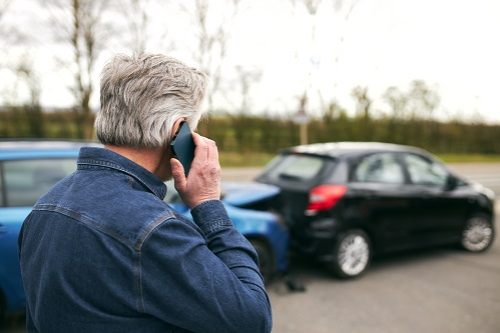- What no-fault insurance is and what it's not
- States that use a no-fault insurance system and how each handles it
- Why do some states use no-fault car insurance?
- How does no-fault auto insurance work?
- What does no-fault insurance cover?
- No-fault insurance advantages: Quicker claims processin
- How to get cheaper rates on no-fault auto insurance
What no-fault insurance is and what it's not
No-fault insurance is a legal system where fault doesn't determine which insurance company pays for injuries. It's not a system where no one found at fault for the accident.
There are three approaches to no-fault auto insurance:
- True no-fault states. No-fault states require you to purchase no-fault insurance. This is also called Personal Injury Protection (PIP) insurance. True no-fault states also restrict your ability to sue an at-fault driver.
- Optional or "choice" no-fault states. Drivers in optional no-fault states can go with the no-fault system or opt out and choose a traditional tort-liability policy. If you've opted in, you abide by the same rules as drivers in true no-fault states, meaning your ability to sue another driver is limited. At the same time, other drivers can't sue you for minor collisions either.
- Traditional liability with PIP states. Some states allow you to add no-fault (PIP) coverage to your traditional liability coverage. In these states, your insurer covers your injury damages regardless of fault, but there are no restrictions concerning lawsuits.
States that use a no-fault insurance system and how each handles it
The states below all have some form of no-fault insurance, either mandated or optional. Below we've outlined the coverage, how lawsuits work, and the average cost of a basic policy in each state.
| State | Coverage | Lawsuit | Avg annual Premium |
|---|---|---|---|
| Arkansas | Not required but must reject in writing. | None | $674 |
| Delaware |
| None | $1102 |
| Florida | $10k per person | Significant permanent injury | $1,144 |
| Hawaii | $10k per person | Significant permanent injury | $739 |
| Kansas |
| Significant permanent injury | $669 |
| Kentucky | $10k per person | $1,000 medical expenses or serious injury | $773 |
| Massachusetts | $8k per person | $2,000 or permanent serious injury | $1,008 |
| Maryland | $2.5k per accident | None | $979 |
| Michigan |
| Death or serious permanent injury | $1,131 |
| Minnesota |
|
| $745 |
| North Dakota | $30k per person | $2,500 medical expenses or serious injury / 60+ days disability | $605 |
| New Hampshire |
| None | $733 |
| New Jersey |
| Significant permanent injury | $1,254 |
| New York |
|
| $1,182 |
| Oregon | $15k per person | None | $783 |
| Pennsylvania | $5k per accident | Significant permanent injury | $841 |
| South Dakota | No minimum | None | $581 |
| Texas | Not required but must reject in writing. | None | $895 |
| Utah |
| $3,000 medical expenses or permanent serious disability or disfigurement | $734 |
| Virginia | No minimum | None | $719 |
| Washington | Not required but must reject in writing. | None | $838 |
| Washington, D.C. |
| Drivers have 60 days to decide to take no-fault benefits or sue the at-fault driver. | $1,187 |
| Wisconsin | Not required but must reject in writing. | None | $621 |
No-fault insurance in Michigan: A special case
According to Michigan’s Department of Insurance and Financial Services, the state requires drivers to purchase no-fault auto insurance that includes the following:
- PIP. This is intended to cover all your medical costs. It pays up to 85% of your lost income for up to three years (up to $5,398 per month) and can pay your family a death benefit in the event you die. PIP benefits include up to $20 per day to purchase household service providers that you must hire due to injury.
- Property protection. Your no-fault auto insurance must pay up to $1 million for damage your car causes to property owned by others.
- Residual liability. Insured people are protected from being sued except in special situations.
Why do some states use no-fault car insurance?
No-fault insurance is designed to reduce lawsuits, expedite injury claims, and keep car insurance rates low.
In true no-fault states, a lawsuit against the at-fault party can take place only for accidents in which the medical expenses reach a certain threshold or the injuries meet the state's legal definition of "serious." No-fault insurance systems were implemented in an attempt to achieve the following:
- Quicker payment of claims
- Victim's reimbursement not split with lawyers
- Lower insurance rates
- Fewer lawsuits to defend and reduced legal costs to insurers
- No subsidizing uninsured motorists
No-fault systems have often failed to contain costs and even resulted in higher costs for several reasons:
- Fraudulent medical claims
- Litigation did not decrease -- instead of suing at-fault drivers, many accident victims switched to suing their own insurers for denied or insufficient reimbursement
- High coverage limits led to exorbitant payouts
- Bad drivers were not punished sufficiently to change behavior
Today, only a dozen states and Puerto Rico have no-fault laws. Other states modified their laws or returned to traditional tort liability systems.
In a tort state, at-fault drivers in a crash are responsible for paying the other driver's medical expenses. The at-fault driver must also pay for additional damages, such as loss of wages and "pain and suffering." This is usually paid out of your liability, personal injury or medical payments coverageAn auto insurance coverage that provides coverage for medical expenses incurred by you and your passengers in the event of an accident, regardless of who is at fault., depending on state requirements.
How does no-fault auto insurance work?
No-fault insurance only kicks in when you're injured in an auto accident. You don't need to contact the other driver's insurer, file witness statements and police reports or wait for the other company's decision to pay (or worse, NOT pay).
The no-fault process works like this:
- You are injured in a car accident.
- Regardless of who is at fault, you file a claim with your insurer for expenses related to your injuries.
- Your insurer reviews your claim and researches the accidents’ circumstances.
- Benefits to which you're entitled are paid by your insurer.
- You may not sue the at-fault party and he/she may not sue you, unless criteria are met for “serious” damages.
It’s important to note that no-fault is for injuries, not property damage. If your car is damaged by another driver in a no-fault state, you can still make a claimAn insurance claim is a request you make to your insurance company for coverage after your car is damaged or you have an accident. You can file a claim online, by phone, or in writing. with the at-fault party’s property damage liability insurer.
What does no-fault insurance cover?
Your policy benefits generally cover:
- Medical bills
- Lost wages
- Funeral expenses in the event of a fatality
- Other expenses that result from the accident
To be compensated for property damage, such as repairs to your car and other property, you must file a traditional liability or collision claim and the insurers will investigate and determine who was at fault and who owes whom. If you're not at fault, the other driver's liability policy should cover your damages; if you caused the accident, your own collision coverage should pay. (Note: collision insurance may not be required if you own your car outright; if you want this coverage, you have to purchase it as an option.)
No-fault restrictions on lawsuits
No-fault laws make it harder to sue for non-economic damages, such as pain and suffering for seemingly minor injuries. If you get whiplash, for example, you're unlikely to meet the threshold for a lawsuit -- soft tissue damage isn't considered a serious injury.
Some states specify the types of injuries that allow you to step outside the no-fault system and file a lawsuit; these are called "verbal" states because the allowed injuries are described in words. Other states set their thresholds at certain levels of medical costs ("monetary" states) or length of disability.
Paying medical costs in a no-fault state
Some states require that you use your PIP benefits to pay medical costs first, then have your health insurer pick up the rest. Other states require you to use your medical insurance first, then use PIP to cover deductibles and non-medical expenses.
In some states, the funds are paid directly to medical providers, while in others, the check goes directly to you.
Will your insurance rates go up if an accident wasn't your fault?
In a no-fault car accident, the term "no-fault" doesn't mean that an insurer cares who's responsible for causing an accident. It just means that injury benefits are paid by each party's insurer without regard to who is at fault. However, both insurers investigate and assign blame.
If the investigation determines that you didn't cause the accident, your rate is unlikely to increase. Michigan, for instance, rates drivers by the number of tickets and at-fault accidents on their records.
In some states, even if you're at least partially to blame for an accident, your rates may not increase, if you have not filed any claims during the past few years.
No-fault insurance advantages: Quicker claims processin
One of the biggest advantages of no-fault car insurance is that there's no need to fight with a second insurance company to get medical bills paid. This reduces claim processing times, which can be dragged out when the insurance companies are waiting on, or arguing, fault before deciding which will pay.
No-fault insurance is also meant to discourage lawsuits, which in turn should discourage insurance fraud. However, this has not always been the case in practice. While no-fault insurance does discourage drivers from suing each other, it doesn't always prevent insurance fraud, which is common in some states, with drivers often exaggerating injuries to collect personal injury protectionPersonal injury protection (PIP) pays for your medical, hospital and funeral expenses resulting from a car accident, regardless of who's at fault. benefits.
How to get cheaper rates on no-fault auto insurance
You can save on your no-fault insurance policy the same way drivers in tort states do:
- Keep a clean driving record to avoid rate increases due to tickets and accidents
- Bundle your home and auto insurance for lower rates
- Ask about all available discounts
- Shop around: rates vary widely by company and it's well worth taking the time to compare quotes.
Methodology
We partnered with Quadrant Information Services to field car insurance rates in all 50 states and Washington, D.C. Rates are based on a state minimum car insurance policy that meets no-fault requirements. They are based on this driver profile:
- 40-year-old driver
- Honda Accord LX
- Good credit
- A clean driving record
- 12-mile commute, 10,000 annual mileage
Learn more about our data and methodology.



